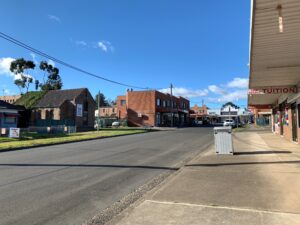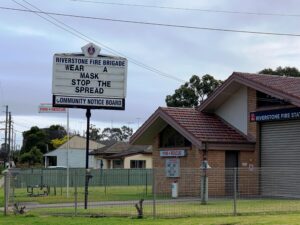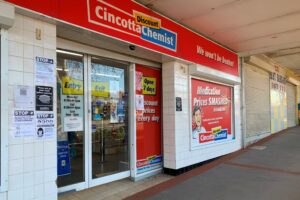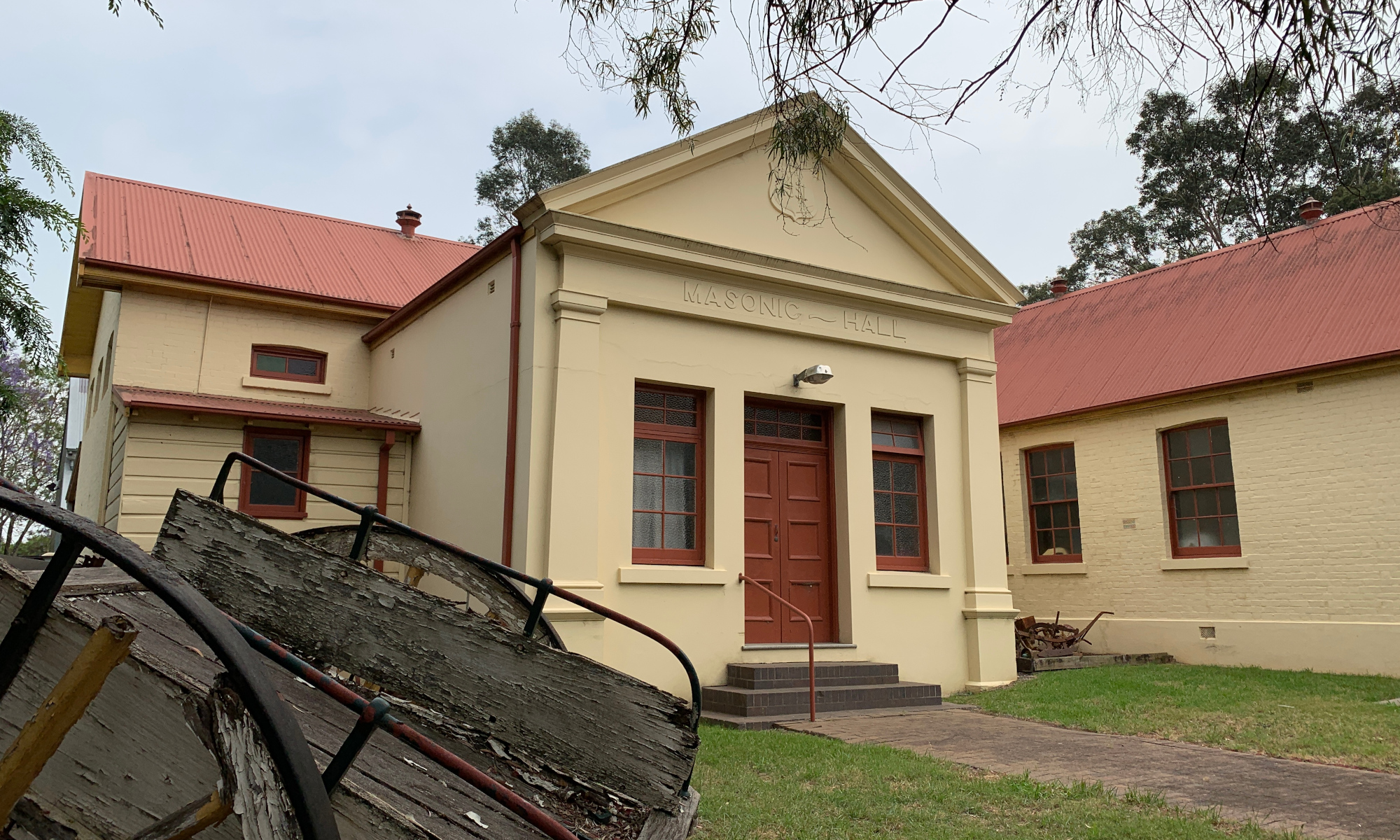by Rosemary Phillis
By the time we hit late November 2020 it felt like we were on top of COVID-19 in New South Wales. We made plans to open the Riverstone Museum in 2021 and looked forward to a Christmas which would look relatively normal.
The virus was not done. There was an outbreak on the Northern Beaches connected to a worker who transported returning travellers and this spread in the community. The Northern Beaches were placed into lockdown and the rest of us watched on.
The State Government had introduced a daily press conference at 11 o’clock each day with the Premier Gladys Berejiklian, Chief Health Officer Kerry Chant, the Health Minister Brad Hazzard. I found myself making sure that I was in front of the television each day to get the latest updates and instructions.
Some general restrictions were implemented for Christmas and then stricter ones implemented for after Christmas.
Several other pockets of transmission opened up in Sydney at Croydon and Berala. From Monday 4 January 2021, in the Greater Sydney area, it was compulsory to wear masks in retail areas, on public transport and other places.
In Riverstone people adapted well and by 5 January everybody I saw when down the street were wearing a mask inside the shops.
As January progressed, there were 0 cases of community transmission. Guidelines were relaxed so that people did not have to wear masks inside shops.
The Historical Society felt secure enough to open the Riverstone Museum for the first time in 12 months, on 7 February 2021. The Magic Metal Motoring car club brought a wonderful display of cars to the Museum to kick off the year in style. Like other businesses we had registered for a QR code so that people visiting the Museum could log in via the Services NSW App or on a paper register sheet. We had a good roll up of visitors as people were keen to be out and about in places like the Museum.
Late February 2021 saw the start of COVID-19 vaccinations in Australia. The first priorities were front line workers, quarantine staff, staff in quarantine hotels, nursing home residents and staff.
New South Wales continued to record 0 community transmission and people began to return to work. Restrictions were gradually lifted and as at early March, public transport was one of the few places were people were still required to wear masks.
19 March was a welcome day for public transport when the restrictions were relaxed to increase the capacity of trains and buses to 75%. There was also no longer a need to sit in every second seat, leaving a 1.5 metre space between people. Community transmission remained 0 in NSW which was a relief, although cases of transmission within quarantine from people returning from overseas were still being recorded.
Monday 29 March was a welcome day when restrictions were eased back to no longer require masks to be worn on public transport and restrictions were lifted on numbers at weddings and funerals. Indoor venues were still subject however to the 2sq metre per person rule.
In April, the vaccination roll out plans were impacted by the linking of the AstraZeneca vaccine to rare blood clots in several people under the age of 50. This was the vaccine in greatest supply available in Australia at that time. The roll out of AstraZeneca was then changed to people over 50, and under 50 restricted to those prepared to sign a waiver form and take the risk. Later, as the statistics showed a higher level in people aged in their 50s, this was then changed to people over 60. This caused confusion and lead to a hesitancy in using AstraZeneca. People held off in the hope of getting the less readily available Pfizer vaccine.
Restrictions were still in place for Anzac Day Services. The local RSL sub-Branch was not in a position to organise the regular dawn service, which is normally attended by thousands. A private service was held by the sub-Branch at the Riverstone Cenotaph and attended by around 100 locals who had gathered at the same time to pay their respects. After the brief service, a pair of commemorative brass boots was officially unveiled at the Cenotaph.
Things continued smoothly in New South Wales until an outbreak linked to a person, who transported an overseas flight crew to and from their accommodation in Sydney, tested positive for the Delta strain. This variant spread more rapidly than others and saw the outbreak grow to 80 local infections. The State Government announced that from 6pm on Saturday 26 June, the Greater Sydney area would be in lockdown for two weeks. This meant only going out in a limited set of conditions including food, essential items, caring, attending medical appointments and of course getting a vaccination. People were required to wear masks when indoors or anywhere outside of their home.
People in Riverstone responded smoothly to the lockdown. Initially it was like a ghost town in the local shopping centre and traffic was light on the roads. Those who were out picking up essential goods from the local shops were wearing masks.
Sadly the new restrictions impacted a large number of local businesses. The majority in the main street and shopping centre had to close, move to appointments only or interaction via phone or video. (Later some had to move to click and collect.)
Although the outbreak in the Greater Sydney area was predominantly around Bondi, COVID testing centres were set up locally. One was at 32 Worcester Road, across from the Anglican School, and the other in the grounds of the Vineyard Church at 357 Windsor Road.
In July the number of cases continued to increase, especially in south western Sydney. Further restrictions were imposed. Exercise and recreation were limited to people’s Local Government Area (LGA) or a maximum of 10 kilometres. In addition, people were required to carry identification showing their address and a mask when out of their home and whilst exercising. Shops were required to have State Government QR sign in codes or paper sign in sheets, and people were required to use them.
The increased restrictions in the Fairfield, Liverpool and Canterbury-Bankstown saw residents only able to leave the area for essential work. They were required to be COVID tested every three days. This impacted on shop keepers in Riverstone. The KM Variety store for example in the main street was closed. For a number of days the Commonwealth Bank did not open for face to face services, leaving customers with only auto teller machines. They son reorganised their staff so that they worked from branches within their LGA.
Local police became more visible, with patrol cars seen more often around Riverstone. One local shopkeepers told me that a policeman came through the shopping centre to make sure that all of the shops had QR codes and that people were using them.

Photo: Rosemary Phillis.
The regular daily 11 am New South Wales COVID update became must see on television for locals. As time went on the lockdown was extended. Record numbers of people were tested daily and the numbers of infected people rose. Sadly some lead to hospitalisations and deaths. Fortunately vaccinations were having a positive effect. Those who had received their second injections were proving less likely to get as sick, or be hospitalised, as those who hadn’t.
The news conference on 23 July brought the news that from 12.01am the next day, the Blacktown LGA, which incorporated Riverstone, would be subject to tougher restrictions.
Kevin Connolly MP posted the following update on his Facebook page on 24 July 2021.
WHAT IS DIFFERENT FOR BLACKTOWN LGA TODAY?
-
-
- The Public Health Order in place for Greater Sydney still applies to Blacktown. Residents must stay at home unless leaving for one of the listed “reasonable excuses”.
- The only change today relates to leaving home for the purpose of WORK. You can leave Blacktown LGA for work purposes only if your occupation is on the list of authorised workers https://www.nsw.gov.au/covid-19/rules/authorised-workers
- There is NO requirement at this stage for testing each 3 days (as applies to Fairfield).
- The other listed reasons for leaving home all remain unchanged: ie. you can go out to do essential shopping; you can go out to exercise in Blacktown LGA or within 10km of home; you can go out for care / compassionate or medical reasons, (including to be vaccinated, get a Covid test or to give blood).
- People who live in Blacktown LGA and who cannot work from home can go to work in Blacktown LGA unaffected by this new restriction.
- People who live in other LGAs (except for Fairfield, Liverpool, Canterbury-B and Cumberland) can still come to Blacktown LGA for work, unaffected by this change.
-
From 30 July, the distance people could travel in the hot spot areas including Blacktown, for exercise or shopping for essential items was reduced to 5 kms.

Photo: Rosemary Phillis.
Although no details appeared in the press, a staff member at a local school tested positive and two students subsequently tested positive. These people must have isolated successfully as no further infections appeared to come from those cases. The local community only knew, because someone posted information on the Riverstone Community Group Facebook page.
So what did life look like around Riverstone by the time the extra lockdown restrictions were introduced?
-About half of the shops in the town were closed. Shops had signs advising customers that they were closed due to COVID-19 restrictions.
– All open businesses had a State Government QR sign in code at the front door. It was compulsory for customers to sign in either using the QR code reader on their smart phones or sign in manually on paper record sheets. This recording was in case an infected person visited the business and would allow others there at the same time to be advised by contact tracers employed by the NSW Government.
– Hairdressers were closed. People’s hair grew longer and in some cases greyer unless they could dye their hair at home.
– Lawn mowing businesses were not allowed to work. People’s lawns started to grow and look shaggy. Luckily it was winter, so the grass, apart from clover, was not growing quickly. Eventually this was removed in time for the spring grass growing season.
– The only bank in town, the Commonwealth, introduced restricted face to face hours from 10am to 2pm. A security guard at the front of the bank ensured that people signed in and that the number of people inside at the one time was limited.
– More people could be seen walking around town for their daily exercise. Pet dogs had never been walked as much.
– No one stopped to chat. Everyone walked with purpose and no-one was hanging around.
– People were encouraged to shop online, using home delivery or click and collect where you ordered and paid, then when the order was ready, stayed outside the business where the employees would put the goods in your boot.
– The other states, particularly Queensland and Western Australia maintained border closures to residents of New South Wales, Sydney and the LGAs of concern. This particularly difficult for locals who were not able to travel or have visitors from interstate.
– Limits on people coming into Australia meant some Australians were stuck overseas. The limits were driven by the number of quarantine spaces available in hotels in Australia. People returning had to quarantine in a designated hotel for 14 days and test negative to COVID-19 before being able to rejoin the community. In addition, most people, unless they had an approved reason were not able to travel overseas.
– Holidays were fairly non existent due to the overseas travel restrictions, state border closures and then restrictions on travel within New South Wales. The latter arising once infections started to rise in the country.
– Some Medical Specialists required patients and carers to have COVID tests within 72 hours of their appointments and to show evidence of a negative test result.

One premises closed and the other displaying a raft of COVID related signs.
Photo: Rosemary Phillis.
The State Government continued to promote several messages every day: – Stay at home/ – Get tested if you have even the mildest of symptoms/ – Get vaccinated.
The numbers of infections continued to increase. From 16 August restrictions increased to reduce exercise and shopping for all greater Sydney to within 5kms of home. Permits were required to visit the rest of the state.
Sadly the number of infections per day rose to nearly 1600, with over many requiring hospital treatment. So far during the latest outbreak over 200 people have died as a result of COVID.
On 15 September restrictions were eased for the LGAs not considered of concern. Further concessions were made for fully vaccinated people. They could for example catch up outdoors with up to 5 other fully vaccinated adults. There was also no limit on the amount of time spent exercising outdoors.
Riverstone being part of the Blacktown LGA was still regarded as an area of concern. The daily figures were based on postcode. For 2765, the number of infections was ranging from about 4-13 per day.
On 20 September, some of the restrictions were eased in the LGAs of concern. Like the other LGAs, people were no longer limited to 1 hour of exercise per day (plus one hour of recreation if fully vaccinated. Once again they could travel within 5 kms of their home or within their LGA for exercise or recreation.
The issue of mental health was recognised by the government and within our community. People tapped into ideas from other areas and came up with new ideas to try and lift morale.
A Facebook page called “Rivorocks” was set up. Locals were encouraged to paint rocks and hide them for others to find, photograph, post on the Facebook, then hide and the leave, keep or remove the rock. It was a hit and became a popular pastime and fun for children and adults.
Another idea was Spoonville. People were encouraged to decorate spoons and place them in their gardens.
Casuarina School, on the corner of Garfield Road and Piccadilly Street, developed a “well being wall”. Individuals, local businesses and organisations were encouraged to provide or email “pictures, paintings, poems, inspirational messages or even your favourite recipe”. These were then printed, laminated and put up on the fence facing Garfield Road.
Another important initiative set up by the Riverstone Community Centre was the “Dollars for Dignity” campaign. This wonderful idea was promoted on Facebook. People were encouraged to donate $10 each online, with the idea being that if 1000 people did this, the Centre would have funds to continue to assist people who were struggling financially. The donations came flooding in from individuals, businesses, sporting and community groups added valuable donations to those made by individuals.
As at the time of writing this article at the end of September 2021, the main hope for a return to a more “normal” life is for rates of fully immunised people to reach at least 70% of the population able to be vaccinated. At present the rates are on target for this to be in mid to late October. This does not mean full opening and back to what was once “normal”, but will see greater freedoms. Like many I am looking forward to it.
